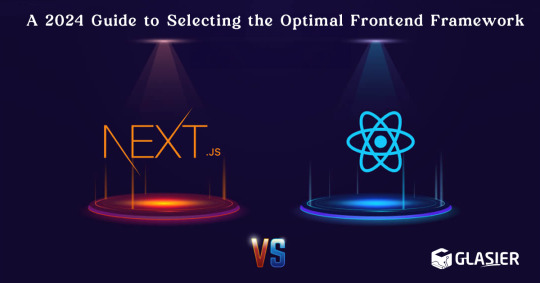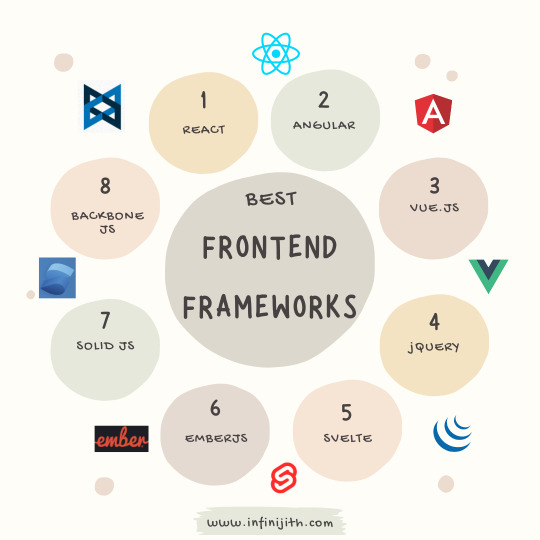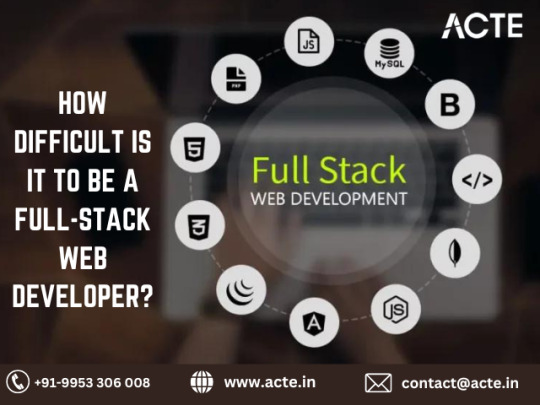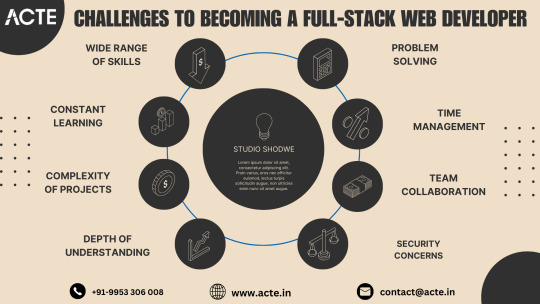#best frontend framework
Text
ReactJs is one of the best & simplest frameworks for web development. It is used for creating user interference in less time. Many big companies use ReactJS to develop web applications. Nowadays Vue.js is the most popular framework for app development. It helps in multiple tasks creating mobile apps & web applications.
0 notes
Photo

React or Vue - Your Best Suited Frontend Framework - Infinijith
Is it baffling to choose between React and Vue? Don't fret!
Our React and Vue developers formed a team, discussed, and wrote a blog on React vs Vue. They made a detailed comparison explaining the pros, cons, examples, uses, and similarities of React and Vue with their project experience.
Interesting, right? Look at the article to figure out the best frontend framework for your project.
If you need to connect with React or Vue developers to discuss more about project queries, feel free to talk to our Infinijith developers.
https://infinijith.com/blog/react/react-vs-vue
#react or vue#reactjs or vuejs#hire react js developers india#hire vue js developers#react vs vue#reactjs vs vuejs#best frontend framework#best js framework
0 notes
Text
Nextjs SEO: Exploring Advanced Techniques for Next.js Websites for Increasing Search Engine Visibility

: This article is focused on SEO experts and Next.js developers looking at advanced techniques with Nextjs SEO! In this article, we will dive deep into detailed techniques specifically tailored for Next.js websites.
From optimizing server-side rendering to leveraging dynamic routing, we'll explore the strategies that will enhance your website's visibility and bring more organic traffic. We'll uncover how to effectively implement structured data, improve page load speed, and create compelling meta tags that capture the attention of both search engines and users.
Whether you're a seasoned SEO professional or a Next.js developer, this article will equip you with the knowledge and tools to propel your Next.js website to new heights in search engine rankings. Get ready to unlock the full potential of SEO for your Next.js project and drive results like never before.
But here's the thing – this journey is ongoing. To really make the most of your Next.js website, think about teaming up with AskGalore Digital. Our experts are ready to take these strategies and customize them just for you. Let's work together to make sure your website not only meets but exceeds its potential on search engines. So, why wait? Choose AskGalore Digital, and let's kickstart your journey to SEO success for your Next.js project.
#Next.js#Next.js developer#SEO#Search Engine Optimization#SEMrush#keyword research#Dynamic routing#Next.js SEO#Advanced SEO techniques#Search engine visibility#SEO optimization#Web development#Frontend frameworks#Website optimization#JavaScript SEO#Web performance#Search engine best practices
0 notes
Text
Best Frontend Framework 2023: Temukan Framework Front-End Terbaik
Best Frontend Framework 2023: Temukan Framework Front-End Terbaik
Hostnic.id – –Halo pembaca yang terhormat, bagaimana kabar kalian? Kami harap semuanya dalam keadaan baik-baik saja. Pada kesempatan kali ini, kami ingin berbicara tentang kerangka kerja frontend terbaik tahun 2023. Mari kita mulai perjalanan ini dengan memperkenalkan beberapa pilihan terkini yang bisa membantu meningkatkan…

View On WordPress
0 notes
Text
Hundreds of frontend development frameworks are available in the surrounding world. Picking up the best one is a tough job. Some platforms are free to use, some are paid, some are easy to learn, while some are hard. Depending on your project requirements and app development partner’s suggestions, you can pick the most suitable framework for your app.
Here are some of the best frontend frameworks to use in 2023:
React
Angular
Node.js
Ember
Foundation
Bootstrap
jQuery
Preact
Express.js, etc.
0 notes
Link
Web Apps have a huge demand in the market as it brings great ease for both company as well as the users to engage and interact with each other and finally end up with potential results. Users majorly attract towards the appealing Interface of the Application and this frontend work really play a crucial role in engaging the users and driving them swiftly from one page to another without distracting them with absurd animations or related. So it is really important to understand about the most preferred Frontend Frameworks offering plethora of delightful UI features. Read the full article for better understanding on the concept.

0 notes
Note
how did you make your own website? & how long did it take you to make it? i am interested in web dev,,, do you have any tips or any helpful sites for beginners/ intermediate? (sorry for asking so many questions!)
hey no problem, asking is a great way to learn always!!
i started on my portfolio site i think around september 2022, forgot about it because of work, then went back to it and deployed it around march 2023! i learned a lot at work, so i just applied what i learned from working in web dev to my own personal site
regarding how to start, if you're a complete beginner, i'd suggest playing around with HTML/CSS first since it's kind of the basic building blocks for doing frontend stuff -- for the first few projects you could try copying simple sites like Google's home page :) there are little interactive tutorials you can find online too like flexbox froggy that can help teach diff concepts in a fun way!
after feeling comfortable with it, i'd suggest playing around with ReactJS when starting out with web dev; it's easy to get into because of its extensive documentation and its large community! there are step-by-step guides into setting it up and several tutorials (both video/article)
if you decide to get into actually deploying your stuff and connecting it to APIs, you can start looking into other frameworks like NextJS/GatsbyJS etc.
getting yourself into a web dev project, like maybe making a small notes/checklist web app or your own portfolio site is a fun way to experiment!! the hardest part is always finding the motivation to start them imo :) wishing u the best on ur web dev journey!!!!! 💗
178 notes
·
View notes
Note
Hi im on my 3rd year of info tech and im just only getting the grasp of it or maybe it's bc we're doing web development this year. i am completely uninterested with the first languages i learned except web design. do i eventually have to go through java and c again when i have to work or before i apply? learning those overwhelmed me so much 😢

First of all, don't do things that overwhelm you to the point it stresses you out. Yes, you might have to do it for your course but you're not interested in it really, so don't do it any further than you have to! There are more fun languages to play around with!
Back to the question: It depends on the job you want to do, to be honest. Some job roles will tell you upfront what languages are a requirement such as 'Java Developer' or 'C# ASP.NET Developer' - you get what I mean, you would probably want to avoid them. But for more vague titles like Software Developer, you need to read into the description of the job or the company to see what their tech stack involves and see what you enjoy and can do matches what they're looking for in a person to join their company!
For example, my job (minus the apprenticeship side) is a Software Developer and it is very JavaScript frameworks, C# and SQL based (with HTML and CSS in the background a bit, of course). So, I didn't and won't need to learn Java or C in order to do my job. Other Software Developer jobs might include Java.
If you are leaning more towards the web design route because that's more interesting, I haven't seen a lot of web design jobs need someone who knows Java or C. Web Design is more UX, UI, visual design, frontend languages and frameworks, SEO, maybe even learning to use programs like Adobe Creative Suite to design the websites. And of course, having 'excellent attention to detail'.
Web Developer is most of those things but add backend web programming languages (such as but not limited to, Python, Java, JavaScript, Ruby, C#, and PHP) and frameworks to the mix. Extra things to know really. Read more about this!!
Basically what I'm trying to say is that:
No, there's a high chance you won't have to learn Java and/or C to get a job only if you're applying for jobs that require it the most
Not all tech jobs require you to know either the two languages
However, that means learning the languages/frameworks that are required if you don't know them already
In Web design/web development, you can get a job in some cases knowing just HTML, CSS, JavaScript, and a couple JavaScript frontend and backend frameworks. Go the extra mile and learn backend stuff like MongoDB, SQL or MySQL - if you want.
See what is available in the job market around you, not everywhere is the same
If you see a common pattern, e.g. a lot of jobs require Vue.js or React.js etc, probably learn them and make a couple projects in them so you're ready to apply for those types of jobs in the future (this is what I'm doing)
━━ ⋆
Links to look at for extra reading/research 🌐
[LINK] - What Are the Main Areas of Development for Web Designers to Land Their Dream Job?
[LINK] - What is the difference between a web developer and a web designer?
[LINK] - How to Become a Front-End Developer - Skills, Roles, Salary Explained
[LINK] - What Qualifications Do You Need to Become a Web Developer?
━━ ⋆
I hope this helps! Keep doing research and I hope only the best for you! 🙌🏾🤎
#my asks#resources#codeblr#progblr#studyblr#programming#coding#comp sci#studying#computer science#cs studyblr#tech#programmer#coding study#career#career advice#computer academia#learn to code#software developer#web design#web dev#web development
37 notes
·
View notes
Text
Frontend Frameworks for Web Development

Frontend Frameworks for Web Development, creating captivating and user-friendly websites and web applications is essential for businesses to thrive. With the increasing demand for dynamic and interactive web experiences, frontend development has become more crucial than ever.
To meet these demands efficiently, developers rely on frontend frameworks, which streamline the development process and enhance productivity.
In this comprehensive guide, we'll explore the world of frontend frameworks for web development, covering everything from key factors to consider when choosing a framework to the top options available in India.
Overview of Frontend Frameworks for Web Development
Frontend frameworks are collections of pre-written code, libraries, and tools that expedite the process of building user interfaces for websites and web applications.
These frameworks provide developers with a structured approach to frontend development, offering ready-made components, templates, and utilities to streamline common tasks.
By leveraging frontend frameworks, developers can achieve consistency, maintainability, and scalability in their projects while focusing more on functionality and user experience.
These frameworks often follow the principles of modularization and component-based architecture, facilitating code reuse and making development more efficient.
Key Factors to Consider in a Frontend Frameworks for Web Development
When choosing a frontend framework for web development, several key factors should be considered:
Community Support: Opt for frameworks with active and robust communities. A strong community ensures ongoing support, frequent updates, and a wealth of resources such as documentation, tutorials, and plugins.
Performance: Evaluate the performance metrics of the framework, including page load times, rendering speed, and resource utilization. A lightweight and efficient framework can significantly impact the user experience.
Flexibility and Customization: Assess the framework's flexibility in accommodating project requirements and its customization options. Look for frameworks that allow developers to tailor components and styles to suit specific design needs.
Learning Curve: Consider the learning curve associated with the framework, especially if you're working with a team of developers with varying skill levels. Choose a framework that aligns with your team's expertise and resources.
Compatibility and Browser Support: Ensure that the framework is compatible with a wide range of browsers and devices, particularly if your target audience includes users with diverse preferences and devices.
Updates and Maintenance: Check the framework's update frequency and long-term maintenance plans. Regular updates and proactive maintenance are essential for addressing security vulnerabilities and compatibility issues.
7 Best Frontend Frameworks for Web Development in India
Now, let's explore some of the top Frontend Frameworks for Web Development widely used by developers in India:
React.js: Developed by Facebook, React.js is a popular JavaScript library for building user interfaces. It emphasizes component-based architecture and virtual DOM for efficient rendering. React's ecosystem includes tools like React Router for routing and Redux for state management.
Angular: Backed by Google, Angular is a comprehensive frontend framework for building robust web applications. It provides features such as two-way data binding, dependency injection, and modular development. Angular offers a full-fledged ecosystem with Angular CLI for project scaffolding and Angular Material for UI components.
Vue.js: Vue.js is an advanced JavaScript framework known for its simplicity and flexibility. It allows developers to incrementally adopt its features and integrate it into existing projects easily. Vue.js offers reactive data binding, virtual DOM, and a rich ecosystem of plugins and components.
Bootstrap: Bootstrap is a popular CSS framework for building responsive and mobile-first websites. It provides a grid system, pre-styled components, and responsive utilities, allowing developers to create sleek and consistent designs quickly. Bootstrap is highly customizable and offers extensive documentation and community support.
Svelte: Svelte is a relatively new frontend framework that focuses on compiling components at build time rather than runtime. This approach results in highly optimized and lightweight web applications. Svelte's simplicity and performance make it an attractive choice for developers seeking efficiency and speed.
Tailwind CSS: Tailwind CSS is a utility-first CSS framework that provides a set of low-level utility classes for building custom designs. It offers a highly customizable and expressive approach to styling, enabling developers to create unique and responsive interfaces without writing custom CSS. Tailwind CSS is gaining popularity for its developer-friendly workflow and rapid prototyping capabilities.
Foundation: Foundation is a responsive front-end framework developed by ZURB, known for its modular and customizable nature. It offers a comprehensive set of CSS and JavaScript components, as well as a robust grid system and a variety of UI elements. Foundation is well-suited for building modern and accessible web projects.
Conclusion for Web Development
Choosing the right Frontend Frameworks for Web Development is crucial to the success of your website development. Consider factors such as community support, performance, flexibility, and compatibility when evaluating different frameworks. Each framework has its strengths and weaknesses, so assess your project requirements and development preferences carefully before making a decision.
Whether you opt for React.js, Angular, Vue.js, or any other frontend framework, prioritize learning and mastering the chosen tool to maximize its potential and deliver exceptional web experiences. Keep abreast of new developments, best practices, and emerging trends in frontend development to stay ahead in this ever-evolving field.
FAQs for Web Development
Q: Which frontend framework is best for beginners?
A: Vue.js and React.js are often recommended for beginners due to their relatively gentle learning curves and extensive documentation.
Q: How do I choose between Angular and React for my project?
A: Consider factors such as project requirements, team expertise, and ecosystem preferences. Angular offers a comprehensive solution with built-in features, while React provides more flexibility and a vibrant ecosystem.
Q: Are frontend frameworks necessary for web development?
A: While not strictly necessary, frontend frameworks greatly simplify and expedite the web development process, especially for complex and dynamic projects. They provide structure, consistency, and efficiency, ultimately enhancing productivity and user experience.
Q: Can I use multiple frontend frameworks in the same project?
A: While technically possible, using multiple frontend frameworks in the same project can lead to complexity, conflicts, and maintenance challenges. It's generally advisable to stick to a single framework to maintain code consistency and streamline development.
More Details
Email: [email protected]
Website: https://censoware.com/
#web development#website development#software development#web developers#pythonprogramming#phpdeveloper#javascriptdeveloper#mern stack development#mobile app development
2 notes
·
View notes
Text
Exploring Essential Laravel Development Tools for Building Powerful Web Applications
Laravel has emerged as one of the most popular PHP frameworks, providing builders a sturdy and green platform for building net packages. Central to the fulfillment of Laravel tasks are the development tools that streamline the improvement process, decorate productiveness, and make certain code quality. In this article, we will delve into the best Laravel development tools that each developer should be acquainted with.
1 Composer: Composer is a dependency manager for PHP that allows you to declare the libraries your project relies upon on and manages them for you. Laravel itself relies closely on Composer for package deal management, making it an essential device for Laravel builders. With Composer, you may without problems upload, eliminate, or update applications, making sure that your Laravel project stays up-to-date with the present day dependencies.
2 Artisan: Artisan is the command-line interface blanketed with Laravel, presenting various helpful instructions for scaffolding, handling migrations, producing controllers, models, and plenty extra. Laravel builders leverage Artisan to automate repetitive tasks and streamline improvement workflows, thereby growing efficiency and productiveness.
3 Laravel Debugbar: Debugging is an crucial component of software program development, and Laravel Debugbar simplifies the debugging procedure by using supplying exact insights into the application's overall performance, queries, views, and greater. It's a accessible device for identifying and resolving problems all through improvement, making sure the clean functioning of your Laravel application.
4 Laravel Telescope: Similar to Laravel Debugbar, Laravel Telescope is a debugging assistant for Laravel programs, presenting actual-time insights into requests, exceptions, database queries, and greater. With its intuitive dashboard, developers can monitor the software's behavior, pick out performance bottlenecks, and optimize hence.
5 Laravel Mix: Laravel Mix offers a fluent API for outlining webpack build steps on your Laravel application. It simplifies asset compilation and preprocessing duties together with compiling SASS or LESS documents, concatenating and minifying JavaScript documents, and dealing with versioning. Laravel Mix significantly streamlines the frontend improvement procedure, permitting builders to attention on building notable consumer reviews.
6 Laravel Horizon: Laravel Horizon is a dashboard and configuration system for Laravel's Redis queue, imparting insights into process throughput, runtime metrics, and more. It enables builders to monitor and control queued jobs efficiently, ensuring most beneficial performance and scalability for Laravel programs that leverage history processing.
7 Laravel Envoyer: Laravel Envoyer is a deployment tool designed specifically for Laravel packages, facilitating seamless deployment workflows with 0 downtime. It automates the deployment process, from pushing code adjustments to more than one servers to executing deployment scripts, thereby minimizing the chance of errors and ensuring smooth deployments.
8 Laravel Dusk: Laravel Dusk is an cease-to-give up browser testing tool for Laravel applications, built on pinnacle of the ChromeDriver and WebDriverIO. It lets in builders to put in writing expressive and dependable browser assessments, making sure that critical user interactions and workflows function as expected across exceptional browsers and environments.
9 Laravel Valet: Laravel Valet gives a light-weight improvement surroundings for Laravel applications on macOS, offering seamless integration with equipment like MySQL, NGINX, and PHP. It simplifies the setup process, permitting developers to consciousness on writing code instead of configuring their development environment.
In end, mastering the vital Laravel development tools noted above is important for building robust, green, and scalable internet packages with Laravel. Whether it's handling dependencies, debugging troubles, optimizing overall performance, or streamlining deployment workflows, those equipment empower Laravel developers to supply outstanding answers that meet the demands of current internet development. Embracing these gear will certainly increase your Laravel improvement enjoy and accelerate your journey toward turning into a talented Laravel developer.
2 notes
·
View notes
Text
Next JS vs React: Which Framework to Choose for Optimal Frontend in 2024.

Read more Blogs,
Visit Website, Glasier Inc.
ReactJS development company
Hire Reactjs developers
Hire SaaS developers
Hire Android app developers
Hire IOS developers
#react js vs next js#next vs react#hire react js developers#hire dedicated developers#hire android developers#hire ios developers#react js development company#mobile app development company#ios app development services#custom software development company#custom software development
2 notes
·
View notes
Photo

Best front end frameworks - Infinijith
Here are the 8 best frontend frameworks in 2022 that can help you developing the best web applications with better UI experience. Here is the list: Angular, React, Vuejs, Emberjs, Solidjs, Backbonejs, Svelte, and jQuery.
Want to hire front end developers in India for your project? Hire them from Infinijith and our developers will help you develop the best app. Visit us now!
https://infinijith.com
0 notes
Text
The Ultimate Guide to Web Development
In today’s digital age, having a strong online presence is crucial for individuals and businesses alike. Whether you’re a seasoned developer or a newcomer to the world of coding, mastering the art of web development opens up a world of opportunities. In this comprehensive guide, we’ll delve into the intricate world of web development, exploring the fundamental concepts, tools, and techniques needed to thrive in this dynamic field. Join us on this journey as we unlock the secrets to creating stunning websites and robust web applications.
Understanding the Foundations
At the core of every successful website lies a solid foundation built upon key principles and technologies. The Ultimate Guide to Web Development begins with an exploration of HTML, CSS, and JavaScript — the building blocks of the web. HTML provides the structure, CSS adds style and aesthetics, while JavaScript injects interactivity and functionality. Together, these three languages form the backbone of web development, empowering developers to craft captivating user experiences.
Collaborating with a Software Development Company in USA
For businesses looking to build robust web applications or enhance their online presence, collaborating with a Software Development Company in USA can be invaluable. These companies offer expertise in a wide range of technologies and services, from custom software development to web design and digital marketing. By partnering with a reputable company, businesses can access the skills and resources needed to bring their vision to life and stay ahead of the competition in today’s digital landscape.
Exploring the Frontend
Once you’ve grasped the basics, it’s time to delve deeper into the frontend realm. From responsive design to user interface (UI) development, there’s no shortage of skills to master. CSS frameworks like Bootstrap and Tailwind CSS streamline the design process, allowing developers to create visually stunning layouts with ease. Meanwhile, JavaScript libraries such as React, Angular, and Vue.js empower developers to build dynamic and interactive frontend experiences.
Embracing Backend Technologies
While the frontend handles the visual aspect of a website, the backend powers its functionality behind the scenes. In this section of The Ultimate Guide to Web Development, we explore the world of server-side programming and database management. Popular backend languages like Python, Node.js, and Ruby on Rails enable developers to create robust server-side applications, while databases such as MySQL, MongoDB, and PostgreSQL store and retrieve data efficiently.
Mastering Full-Stack Development
With a solid understanding of both frontend and backend technologies, aspiring developers can embark on the journey of full-stack development as a Software Development company in USA. Combining the best of both worlds, full-stack developers possess the skills to build end-to-end web solutions from scratch. Whether it’s creating RESTful APIs, integrating third-party services, or optimizing performance, mastering full-stack development opens doors to endless possibilities in the digital landscape.
Optimizing for Performance and Accessibility
In today’s fast-paced world, users expect websites to load quickly and perform seamlessly across all devices. As such, optimizing performance and ensuring accessibility are paramount considerations for web developers. From minimizing file sizes and leveraging caching techniques to adhering to web accessibility standards such as WCAG (Web Content Accessibility Guidelines), every aspect of development plays a crucial role in delivering an exceptional user experience.
Staying Ahead with Emerging Technologies
The field of web development is constantly evolving, with new technologies and trends emerging at a rapid pace. In this ever-changing landscape, staying ahead of the curve is essential for success. Whether it’s adopting progressive web app (PWA) technologies, harnessing the power of machine learning and artificial intelligence, or embracing the latest frontend frameworks, keeping abreast of emerging technologies is key to maintaining a competitive edge.
Collaborating with a Software Development Company in USA
For businesses looking to elevate their online presence, partnering with a reputable software development company in USA can be a game-changer. With a wealth of experience and expertise, these companies offer tailored solutions to meet the unique needs of their clients. Whether it’s custom web development, e-commerce solutions, or enterprise-grade applications, collaborating with a trusted partner ensures seamless execution and unparalleled results.
Conclusion: Unlocking the Potential of Web Development
As we conclude our journey through The Ultimate Guide to Web Development, it’s clear that mastering the art of web development is more than just writing code — it’s about creating experiences that captivate and inspire. Whether you’re a novice coder or a seasoned veteran, the world of web development offers endless opportunities for growth and innovation. By understanding the fundamental principles, embracing emerging technologies, and collaborating with industry experts, you can unlock the full potential of web development and shape the digital landscape for years to come.
2 notes
·
View notes
Text
Getting Started with Full-Stack Web Development: Obstacles and Opportunities
Embarking on the journey to becoming a full-stack web developer offers a blend of exhilarating challenges and rewarding accomplishments. In this guide, we'll explore the intricacies of mastering full-stack development, delving into the obstacles you may face along the way and the triumphs that await those who persevere.

Introduction
Mastering full-stack web development is akin to embarking on a thrilling adventure—one that promises countless opportunities for growth, innovation, and professional fulfillment. However, the road to proficiency is not without its hurdles. In this blog, we'll navigate through the challenges aspiring full-stack developers may encounter, as well as the triumphs that come with overcoming them.
1. Diverse Skill Set
Full-stack web development demands proficiency in a diverse range of skills, spanning from frontend technologies like HTML, CSS, and JavaScript to backend languages such as Python, Ruby, or Node.js. Additionally, expertise in databases, server management, and deployment processes is crucial. Acquiring mastery in these areas requires dedication, time, and a continuous commitment to learning and adaptation.
2. Ever-Evolving Landscape
The realm of web development is in a perpetual state of evolution, with new frameworks, libraries, and tools emerging at a rapid pace. Keeping pace with these advancements and constantly updating your skill set is imperative to remain competitive in the industry. Allocate time to explore emerging technologies, enroll in online courses, and engage with the developer community to stay ahead of the curve.
3. Complexity of Projects
Full-stack developers often tackle intricate projects that necessitate the integration of various technologies and components. Managing the intricacies of these projects, troubleshooting issues, and ensuring seamless interaction between frontend and backend systems can be daunting. Nonetheless, overcoming these challenges cultivates invaluable problem-solving skills and deepens your comprehension of web development principles.
4. In-Depth Understanding
To excel as a full-stack developer, a profound understanding of programming concepts, algorithms, and data structures is indispensable. Mastery of these foundational principles empowers you to write concise, efficient code and tackle complex technical challenges with confidence. Dedicate time to delve into computer science fundamentals and engage in coding exercises to fortify your expertise.

5. Effective Problem Solving
Effective problem-solving is a hallmark of successful full-stack developers. Debugging code, identifying bottlenecks, and optimizing performance demand astute analytical skills and a systematic approach. Collaborating with peers, leveraging online resources, and seeking mentorship can facilitate the navigation of complex technical hurdles and yield effective solutions.
6. Strategic Time Management
Balancing multiple responsibilities, including frontend and backend development, database management, and project deployment, necessitates adept time management skills. Prioritize tasks, establish realistic timelines, and leverage productivity tools to streamline your workflow and maximize productivity. Reserve time for ongoing learning and professional development to continually enhance your skill set.
7. Cultivating Team Collaboration
Full-stack developers often collaborate with interdisciplinary teams, comprising designers, frontend developers, backend developers, and other stakeholders. Effective communication, teamwork, and collaboration are vital for project success. Foster strong interpersonal relationships, actively contribute in team settings, and cultivate a culture of open communication and collaboration within your team.
8. Prioritizing Security
Understanding security best practices and implementing robust security measures is paramount in web development. Full-stack developers must remain vigilant in identifying and mitigating security vulnerabilities to safeguard sensitive data and uphold the integrity of web applications. Stay informed about prevalent security threats, adhere to industry best practices, and consistently update your knowledge to proactively address emerging risks.
Conclusion
Embarking on the journey to becoming a full-stack web developer is a thrilling endeavor marked by challenges and triumphs. By embracing the obstacles, refining your skills, and maintaining a steadfast commitment to learning and growth, you can unlock a realm of opportunities and embark on a gratifying career in web development. Remember, each challenge surmounted brings you closer to mastery, and the journey itself is as enriching as the destination.
#full stack developer#education#information#full stack web development#web development#front end development#full stack developer course#technology#backend
2 notes
·
View notes
Text
Best Frontend Frameworks in 2023
Web development is a trendy topic to work on in the current industry. Users prefer apps with interactive and animated UI as they are easy to use and understand.
Front-end developers use different front-end frameworks to develop interactive UI of the app/website. Here’s the list of best frontend frameworks that one can rely on for the latest frontend development:
React
Angular
Vue
Bootstrap
MaterialUI and many more
0 notes
Text
Advanced Web Development Tools For Efficient PHP Developers

Web Development is working with frontend and backend both languages that are used by programmers and developers to build a well-functioning website or web application. Some of the most commonly used frontend languages are JavaScript, Angular, React, and Vue and backend languages are Python, Java, PHP, and C#.
PHP is the fastest and most widely used server-side scripting language that is ubiquitous in websites and web app development. It is known as a general-purpose scripting language that can be used to develop dynamic and interactive websites. It offers plenty of frameworks and supports several automation tools for application testing and deployment.
Nowadays the market is flooded with many PHP tools, and choosing the right one from among them is a challenging task. Here, we have made a list of leading tools that your development team can utilize to build feature-rich and innovative PHP webs and applications in 2023.
PHPStorm
PHPStorm is the most standard choice because of its nature of being lightweight, extremely fast, and smooth. It simplifies time-consuming tasks such as static code analysis, debugging, and generating functions. PHPStorm is compatible with many frameworks like Symphony, Drupal, Zend, WordPress, Magento, Laravel, etc.
Sublime Text
One of the most customizable, as well as malleable text editors out there for PHP developers, is Sublime Text. This cross-platform source code editor natively supports multiple coding and native mark-up languages.
AWS Cloud9
One of the main benefits of AWS Cloud9 is it is a cloud-based service, which means that it can be accessed from any computer with an internet connection. AWS Cloud9 comes with a code editor, terminal, debugger, and all necessary programming language tools, such as JavaScript, Python, and PHP, etc. It is an impressive feature-filled software that facilitates real-time code collaboration.
Netbeans
Netbeans supports building large-scale web apps and offers a range of languages like English, Simplified Chinese, Brazilian, Japanese, Portuguese, and Russian. It is considered one of the best software for PHP development and is most commonly used for developing PHP applications.
Aptana Studio
Aptana Studio is an open-source integrated development environment (IDE) for building dynamic web applications that use AJAX, PHP, JavaScript, and Ruby on Rails as well as HTML and CSS. It is enabling developers to develop web apps quickly and easily. Its core features include a code assist, built-in terminal, deployment wizard, and integrated debugger.
CodeLobster
CodeLobster IDE from Codelobster software company is the most popular well-liked PHP dev tool for the developer community. It endorses most PHP frameworks like Drupal, Joomla, Symfony, CodeIgniter, Magneto, CakePHP, etc. It supports numerous plugins and a PHP debugger to validate code. It can accelerate and simplify the development process.
Eclipse
It has a huge community of developers who work on all sorts of plug-ins and equip Eclipse with features. Eclipse features include the Eclipse ecosystem, code assist, syntax highlighting, code templates, syntax validation, code formatting, code navigation, and PHP debugging. These features make it easier for you to write better code.
Zend Studio
Zend Studio is a complete Integrated Development Environment (IDE) for professional PHP Web development, debugging, deploying, and managing PHP apps. It is a suitable option for anyone who wants to develop web applications with PHP version 5.5 and above. It offers fast coding along with an intelligent code editor and integrates with Zend Debugger, X-ray, and Xdebug.
These PHP web tools will set up configuration, complete your code intelligently, help to navigate, and check for errors. They are generally open-source and offer excellent features like syntax highlighting and debugging. They will help increase your productivity and efficiency. If you’re planning to get a web app with PHP, then you can contact Swayam Infotech and schedule a meeting for a detailed discussion. Our PHP experts will guide you with your requirements in a perfect way.
#PHP#php developer#php developers#php development#php development solutions#PHP Web Development#php website#php website development#phpdevelopment#Web Developers#Web Development#web development services#website Development#websites
5 notes
·
View notes